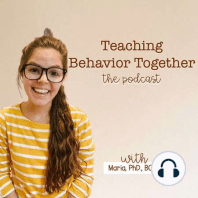9 min listen

3 Easy Ways to Deliver Praise
3 Easy Ways to Deliver Praise
ratings:
Length:
6 minutes
Released:
Jan 4, 2022
Format:
Podcast episode
Description
Hello everyone, and welcome back to the teaching behavior together podcast. Wow, it has If you have been around for a while you know how much I talk about reinforcement. We often think of reinforcement as a tangible object we give someone for appropriate behavior. However, reinforcement is anything that occurs after a behavior that increases the behavior in the future. We know we have reinforced a behavior if it occurs again. Reinforcement happens all day everyday around us. One form of reinforcement can be praise. Often we hear things like, nice work, great job, awesome! However, praise is most effective if it is personal and specific. Here are three strategies to up your praise game.The first strategy is called post it praise. Before your class, jot down a couple of praise statements you might give to your students. These might be general praise statements, like great work staying on task, or more specific praise statements related to the activity you are working on, such as nice job completing that puzzle. I would say, write down maybe 10 and pass them out as you are completing the activity. This is an easy, unobtrusive way to guarantee to you provide praise during your lesson or activity. Sometimes, we get so caught up in the lesson and answering questions and helping students we forget to acknowledge all the behaviors we want to see! Another strategy would be to use some compliment cards. These are very similar to post it praise statements, but you might give these out at the end of the day. You might write 5 of them prior to the end of the day and give them to your students. You can compliment progress towards goals they have or if you saw them helping others in the classroom, any behaviors you want to increase you can compliment! Finally, you can use some nonverbal acknowledgements. You can give students a thumbs up, a smile from across the room, a nod in their direction. These might seem like very small moments, however, for some of our students who do not like attention from a public praise statement, nonverbals can be the way to go. You can also create secret signals with some of your students. Believe me, this makes their day. These are all examples of delivering praise in your classroom that does not involve you repeating yourself over with the same old same old, great work, nice job. They are all personal forms of praise that have the potential to mean a lot to your students. Try one to two out and let me know over on Instagram how they work for you! One thing to note, praise is not a form of reinforcement for everyone, if you do not see and increase or maintenance in behavior, praise might be reinforcing for that student, don’t worry though, subscribe to this podcast so you are notified each week when a new episode comes out. There are many more strategies to come!Resources Discussed in this EpisodeFree Compliment CardsFree Behavior Intervention GuideFollow me on InstagramJoin my email list
Released:
Jan 4, 2022
Format:
Podcast episode
Titles in the series (65)
Let's Get to Know Each Other by The Teaching Behavior Together Podcast